Caesar: Rome vs. Gaul marks the return of designer Mark Simonitch to card-driven wargames. His first such game, Successors, co-designed with Richard Berg, was first released by Avalon Hill in 1997 and covers the events following Alexander the Great’s death as his generals vied for control of his empire. He also designed Hannibal: Rome vs. Carthage about the Second Punic War. In this game, published by GMT Games, Simonitch recreates the struggle between the ambitious Julius Caesar and the Gallic tribes of what today is France and Belgium.
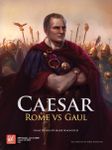
Card-Driven, Point-to-Point Movement Wargames
Before we get to the particulars of this title, let’s review some of the common features of card-driven, point-to-point movement wargames. The granddaddy of the genre was Mark Hermann’s We the People. Rather than using hexagon (or hexes) to regulate the movement of units, the game’s map used a point-to-point movement system. Moving from one space to another usually costs one movement point. Movement across rougher terrain, such as mountains, might cost more. In addition, the combat units were represented by generic strength points rather than specific formations. It also included named leaders who could move whole armies, within limits.
The other major innovation revolved around the playing of cards. In We the People, there were two types of cards: events cards that could be used for their printed event, and strategy cards that could be used for their point value to place control markers in empty spaces, activate and move leaders and units, or raise reinforcements. Later games combined these capabilities, thus allowing players to use the card for its event or its point value, or in some cases both.
A plethora of wargames have followed, and even expanded, on these general design principles. In addition to those already mentioned, there are The Napoleonic Wars, The Halls of Montezuma, and Paths of Glory to name but a few. Each game added unique twists to this general system. Caesar: Rome vs. Gaul is no different in that respect. But whereas many of these other games focus on military clashes, players will find that expanding their influence is as important, if not more so, than winning battles in Caesar: Rome vs. Gaul.
Historical Context
Gaius Julius Caesar was elected one of Rome’s two Consuls in 59 BC. Each consul was elected for a 1-year term, and then was normally assigned to be a governor of one of Rome’s provinces for a term of several years after their consulship ended. Caesar’s enemies in the Senate tried to prevent him from being assigned as a governor, but he was able to thwart their schemes by forming an alliance with Gnaeus Pompeius Magnus (aka Pompey the Great) and Marcus Licinius Crassus, the richest man in Rome. Known as the first Triumvirate, this was an alliance of convenience since the triumvirs were previously rivals. With their help, Caesar was appointed governor of Cisalpine Gaul (northern Italy) and Illyicrium (the Balkans). Through more political maneuvering, Transalpine Gaul (southern France) was added to Caesar’s governorship after the Roman governor there died unexpectedly.
By this time Caesar was deeply in debt to Crassus and others. If he returned to Rome in that state at the end of his governorship, his enemies would quickly ruin him. However, being a governor also gave him the means to eradicate his debts. Using the pretext of Gallic raids into Transalpine Gaul, Caesar launched a series of campaigns against the Gallic tribes of what was then known as Celtica and Belgica. He also crossed the Rhine River as retaliation for Germanic incursions into Gallic territory, and even conducted a brief invasion of Britannia. These are the events depicted in the game.
Besides gaining huge new territories for Rome, Caesar was able to plunder the wealth of the Gallic tribes, who were not the unskilled barbarians they are typically portrayed as. He gained even more wealth by selling captives into slavery, unfortunately a common practice in antiquity. These proceeds were shared with his legionaries, thus cementing their loyalty to Caesar, not to the Senate back in Rome. When the Senate finally recalled him to Rome to face charges of corruption, Caesar opted to cross the Rubicon River with his legions into Italy proper violating Roman law and custom. Doing so inaugurated the civil wars that eventually caused the downfall of the Roman Republic and the establishment of Imperial rule.
Game Components
The game comes with a mounted map board covering six major regions: Celtica, Belgica, and Aquitania (nominally controlled by the Guals), Germania, Britannia, and Provincia (this last is a Roman province). The map board is clear and functional, and includes some unit holding boxes and tracks that are used throughout the game. The playing pieces are cardboard counters, and include combat units, leaders, Influence Markers (IMs), strongholds, fortified towns, walled cities, and administrative counters. The game also comes with two player aid cards, four six-sided dice (two for the Romans and two for the Gauls), and a deck of 55 extra-large Strategy Cards.
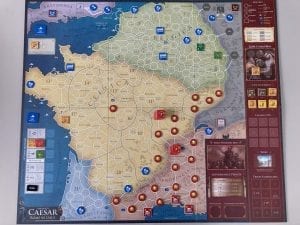
The Strategy Cards are the heart of the game. Each card’s action point value is color coded; red for the Romans, blue for the Gauls, and white for either player. Players can only use a card for its event if it is in their color or white. Otherwise, they must use it for its action point value. Some cards are marked Bonus and allow the owner to play it for both the event (assuming it’s the right color) and its action point value. Still others are marked Surprise and can be used during an opponent’s turn. Besides being super-sized, the cards are exquisitely illustrated. GMT even included sleeves for these extra-large cards…a very welcome bonus.
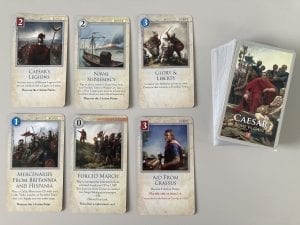
The 24-page rulebook is in color and fully illustrated. The front cover includes a table of contents, and is followed by 18 pages of game rules, a 4-page fully illustrated extended example of play, and a rear cover that contains an index. The rules are clearly written, concise, and include illustrated examples to help explain key concepts. In other words, the rulebook is an example of what all wargame rulebooks should be.

How the Game is Played
Like most wargames, each turn follows a prescribed sequence of play. During the Reinforcement Phase, the Gallic player randomly selects three tribes to enter play. They are placed in their home tribal area along with a fortified town. The Romans then receive up to two replacements for their legions, although they can receive emergency replacements by eliminating Influence Markers in Provincia. The Romans then roll a single die to see if Caesar must stay in Rome to deal with his political rivals or return to Gaul. In addition to Caesar, the Roman randomly selects two Legates to help him command the legions. Both players are then dealt eight Strategy cards.
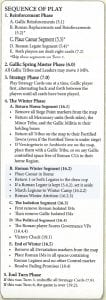
In the Gallic Spring Muster Phase, all tribes can move up to three movement points. This allows the Gauls to consolidate their forces, assuming they are near enough to each other, or make a dash into Roman-controlled territory. In the Strategy Phase, players alternate playing cards, with the Gauls going first unless the Romans have the Winter Offensive card in their hand. If the card is in the player’s color or white, they can choose to use it for its printed event or its action point value. If not, they can only use it for its action points. Action points can be used to place Influence Markers (IMs) in an empty space, convert an enemy IM into a friendly IM in a space containing one of your combat units, or activate a leader or combat unit.
This last option allows the leader and accompanying combat units, or individual combat units without leaders, to use their movement point value to move, conduct sieges of strongholds, fortified towns, and walled cities, and remove enemy IMs. If combat units enter a space with other enemy combat units, movement is halted, and combat occurs. Combat units can opt to avoid battle by rolling a 9 or higher on two dice. This roll can be modified by the presence of leaders and other factors. If successful, the defender moves one space away. If the original attacker still has movement points remaining, then can continue to pursue the enemy. In a similar fashion, combat units can intercept combat units that move adjacent to them by also rolling a 9 or higher.
Combat itself is rather simple. Both sides total the strength points they have in the space. If the battle occurs in a province where one side has most of the spaces controlled via IMs, they get 2 extra strength points representing local troops. They then roll 2 dice and cross reference the strength points with their roll to determine how many hit points they inflict on their opponent. To represent the discipline and training of the legions, any die roll of 1 or 2 is immediately increased to 3. Both sides can use their commanding general’s Battle Rating to force any die, their own or their opponent’s, to be rerolled. Once both players have exhausted their reroll opportunities, the results are applied to both sides. The side that takes more losses is the loser and must retreat from the space.

Once all action cards are played, the Winter Phase commences. All Gallic tribes return to the fortified town in their home province, and the legions march to their winter quarters, bearing in mind that each space has varying winter forage capacities as explained in the rules. Caesar returns to Rome and the Roman player can decide to return one or both legates to the draw cup. Any isolated IMs are removed, Roman IMs first, and the Roman player determines how many Governance Points were earned that turn. The number of Governance Points earned depends on whether they have dominance in each of the three Gallic regions or just a presence. Victory points (0, 1 or 2) are then awarded to the Roman player based on the number of Governance Points. They can also be awarded for invading Germania and Britannia, eliminating Gallic tribes, and other means.
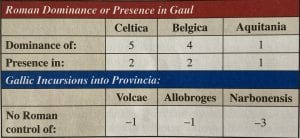
The Gauls win an automatic victory if Caesar earns 3 or less victory points that turn, and the Romans win if there are no fortified towns on the board and they control most of the provinces in Celtica, Belgica and Aquitania, and still control Provincia. Otherwise play continues with the next turn. If neither side achieves an automatic victory, the winner is determined after the end of turn 6. The Roman must have accumulated 12 victory points to win. Any less and the Gauls win.
Impressions
The Roman player will find that they cannot win the game through military means alone. While Caesar, with his 3 reroll options and ability to move up to 6 legions 5 spaces makes him by far the most potent force in the game, the Roman only receives 1 victory point for every 4 tribes eliminated in combat. Instead, the Roman must concentrate on spreading influence so they can dominate Celtica and/or Belgica, which are worth 5 and 4 Governance points respectively. Doing so will increase the odds of gaining needed victory points during the game. Another tactic is to force tribes to submit to Roman rule by besieging unoccupied fortified towns. These towns automatically submit on odds of 3 to 1, and when they do their corresponding combat unit is sent to the Submitted Tribes holding box. Since 3 new tribes enter each Reinforcement Phase, this is the best way to keep the number of tribes to a minimum and gain control of provinces.

In some respects, Caesar: Rome vs. Gaul bears similarity to COIN (short for counterinsurgency) games. Controlling territory by expanding your influence is more important than destroying enemy combat units through direct military action. The Gauls just need to harass the Romans and stymie their efforts to gain dominance in Celtica and Belgica. Caesar is essentially playing whack-a-mole against the Gauls who keep popping all over the board converting Romans IMs to Gallic ones. Time is definitely on the Gauls’ side.
Each turn plays rapidly, although some players may suffer a bit of analysis paralysis deciding which card to play and whether to use it for the event or the action points. The game mechanics are straightforward, and should be mastered with ease, especially if you played similar card-driven wargames before. Given the asymmetry between the two sides, players will need to adapt their tactics accordingly. The game also has good replay potential since the tribes and legates that arrive each turn are determined randomly, as are the cards you’re dealt. The beautiful card artwork enhances the entire experience.
Summary
Designer Mark Simonitch is perhaps better known recently for his hex and counter wargames, including some of my favorites like Holland ‘44 and Stalingrad ’42. However, his return to the card-driven wargame genre with Caesar: Rome vs. Gaul has been worth the wait. If you’re in the market for a medium weight wargame, with great components and good balance, you need look no further.












Add Comment